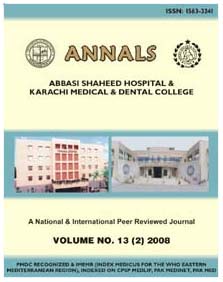
| |
| Home |
| Editorial Staff |
| Instruction to Authors |
| Journal-Issues |
| Policy |
| Copyright |
| VISUAL OUTCOME AND COMPLICATIONS OF PHACOEMULSIFICATION CATRACT SURGERY PERFORMED BY RESIDENTS AT AL IBRAHIM EYE HOSPITAL, KARACHI
MAZHAR UL HASSAN*, RASHID H. ALVI+, NAIMATULLAH SIAL*, AZIZ UR REHMAN*, NASIR BHATTI*, HASSAN RAZA JAFRI*, ASHRAF DAWOOD*. ABSTRACT ABSTRACT Aim: To describe visual outcome and the complications related to cataract surgery performed by phacoemulsification technique by fourth-year ophthalmology residents at Al-ibrahim eye hospital,Karachi, who are trained to perform phacoemulsification with prior experience with manual extracapsular extraction. Design: Prospective, observational case series. Methods: We prospectively analyzed the incidence of complications and visual outcomes in the initial 575 phacoemulsifications (575 patients) performed by the 5 residents learning phacoemulsification in our training programe. All were experienced in standard (manual) extra capsular cataract extraction. Postoperative follow up of 6 weeks was available in 547 eyes. The 28 patients (28 eyes) lost to follow up did not have any intra-operative complications. Results: Of 575 cataract surgeries, 559 eyes (97.2%) were performed using phacoemulsification technique. Posterior capsule disruption without vitreous loss occurred in 16 (2.8%), vitreous loss in 15 (2.6%) and IOL displaced into vitreous in 4 (0.7%) of 559 cases that underwent phacoemulsification technique. Other complications encountered included localized corneal edema (23 eyes), iris damage inferiorly (1 eye ) and clinical cystoid macular edema (1 eyes). A best corrected visual acuity of 6/12 or better was obtained in 521 eyes (95.2%) of the 547 eyes available for the six week follow up. In the eyes with vitreous loss, 10 out of 15 had visual acuity better than 6/12. Conclusion: The residents can perform phacoemulsification well with a very low complication rate, with prior training with extra capsular cataract extraction technique.
|
For Full text contact to:
|
|
*Isra Postgraduate Institute of Ophthalmology,
Al Ibrahim Eye Hospital, Karachi
|

Copyright © 2009 Abbbas Shaheed Hospital and Karachi Medical & Dental College.
All rights reserved.
Designed & Developed by: Creative Designers